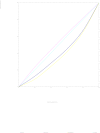Identifying determinants of socioeconomic inequality in health service utilization among patients with chronic non-communicable diseases in China
- PMID: 24960168
- PMCID: PMC4069022
- DOI: 10.1371/journal.pone.0100231
Identifying determinants of socioeconomic inequality in health service utilization among patients with chronic non-communicable diseases in China
Abstract
Background: People with chronic non-communicable diseases (NCD) are particularly vulnerable to socioeconomic inequality due to their long-term expensive health needs. This study aimed to assess socioeconomic-related inequality in health service utilization among NCD patients in China and to analyze factors associated with this disparity.
Methods: Data were taken from the 2008 Chinese National Health Survey, in which a multiple stage stratified random sampling method was employed to survey 56,456 households. We analyzed the distribution of actual use, need-expected use, and need-standardized usage of outpatient services (over a two-week period) and inpatient services (over one-year) across different income groups in 27,233 adult respondents who reported as having a NCD. We used a concentration index to measure inequality in the distribution of health services, which was expressed as HI (Horizontal Inequity Index) for need-standardized use of services. A non-linear probit regression model was employed to detect inequality across socio-economic groups.
Results: Pro-rich inequity in health services among NCD patients was more substantial than the average population. A higher degree of pro-rich inequity (HI = 0.253) was found in inpatient services compared to outpatient services (HI = 0.089). Despite a greater need for health services amongst those of lower socio-economic status, their actual use is much less than their more affluent counterparts. Health service underuse by the poor and overuse by the affluent are evident. Household income disparity was the greatest inequality factor in NCD service use for both outpatients (71.3%) and inpatients (108%), more so than health insurance policies. Some medical insurance schemes, such as the MIUE, actually made a pro-rich contribution to health service inequality (16.1% for outpatient and 12.1% for inpatient).
Conclusions: Inequality in health services amongst NCD patients in China remains largely determined by patient financial capability. The current insurance schemes are insufficient to address this inequity. A comprehensive social policy that encompasses a more progressive taxation package and redistribution of social capital as well as pro-poor welfare is needed.
Conflict of interest statement
Figures


Similar articles
-
Growing old before growing rich: inequality in health service utilization among the mid-aged and elderly in Gansu and Zhejiang Provinces, China.BMC Health Serv Res. 2012 Sep 4;12:302. doi: 10.1186/1472-6963-12-302. BMC Health Serv Res. 2012. PMID: 22947369 Free PMC article.
-
Influencing factors of inequity in health services utilization among the elderly in China.Int J Equity Health. 2018 Sep 15;17(1):144. doi: 10.1186/s12939-018-0861-6. Int J Equity Health. 2018. PMID: 30219075 Free PMC article.
-
Can integration reduce inequity in healthcare utilization? Evidence and hurdles in China.BMC Health Serv Res. 2019 Sep 10;19(1):654. doi: 10.1186/s12913-019-4480-8. BMC Health Serv Res. 2019. PMID: 31500617 Free PMC article.
-
Personalisation schemes in social care and inequality: review of the evidence and early theorising.Int J Equity Health. 2019 Nov 6;18(1):170. doi: 10.1186/s12939-019-1075-2. Int J Equity Health. 2019. PMID: 31694649 Free PMC article.
-
Inequalities in utilization and provision of dental services: a scoping review.Syst Rev. 2021 Aug 10;10(1):222. doi: 10.1186/s13643-021-01779-2. Syst Rev. 2021. PMID: 34376247 Free PMC article.
Cited by
-
Effect of medical insurance and family financial risk on healthcare utilisation by patients with chronic diseases in China: a cross-sectional study.BMJ Open. 2019 Nov 19;9(11):e030799. doi: 10.1136/bmjopen-2019-030799. BMJ Open. 2019. PMID: 31748294 Free PMC article.
-
Horizontal inequity trends of health care utilization in rural China after the medicine and healthcare system reform: based on longitudinal data from 2010 to 2018.Int J Equity Health. 2023 May 17;22(1):90. doi: 10.1186/s12939-023-01908-4. Int J Equity Health. 2023. PMID: 37194035 Free PMC article.
-
Inequity in the healthcare utilization among latent classes of elderly people with chronic diseases and decomposition analysis in China.BMC Geriatr. 2022 Nov 11;22(1):846. doi: 10.1186/s12877-022-03538-x. BMC Geriatr. 2022. PMID: 36357825 Free PMC article.
-
Household financial burden associated with healthcare for older people in Viet Nam: a cross-sectional survey.Health Res Policy Syst. 2022 Nov 29;20(Suppl 1):112. doi: 10.1186/s12961-022-00913-3. Health Res Policy Syst. 2022. PMID: 36443746 Free PMC article.
-
Correlates of unequal access to preventive care in China: a multilevel analysis of national data from the 2011 China Health and Nutrition Survey.BMC Health Serv Res. 2016 May 12;16:177. doi: 10.1186/s12913-016-1426-2. BMC Health Serv Res. 2016. PMID: 27177034 Free PMC article.
References
-
- Liu Y, Hsiao WC, Eggleston K (1999) Equity in health and health care: the Chinese experience. Social Science & Medicine 49(10): 1349–56. - PubMed
-
- Ministry of Health (2005) Chinese Health Statistical Digest 2004. Beijing: Ministry of Health.
-
- Meng Q, Xu L, Zhang Y, Qian J, Cai M, et al. (2012) Trends in access to health services and financial protection in China between 2003 and 2011: a cross-sectional study. The Lancet 379(9818): 805–814. - PubMed
-
- Center for Health Statistics and Information of MOH (2009) An Analysis Report of 2008 National Health Services Survey in China. Beijing: Union Medical University Press.
-
- Gao J, Tang S, Tolhurst R, Rao K (2001) Changing access to health services in urban China: implications for equity. Health Policy & Planning 16(3): 302–12. - PubMed
Publication types
MeSH terms
LinkOut - more resources
Full Text Sources
Other Literature Sources
Medical

